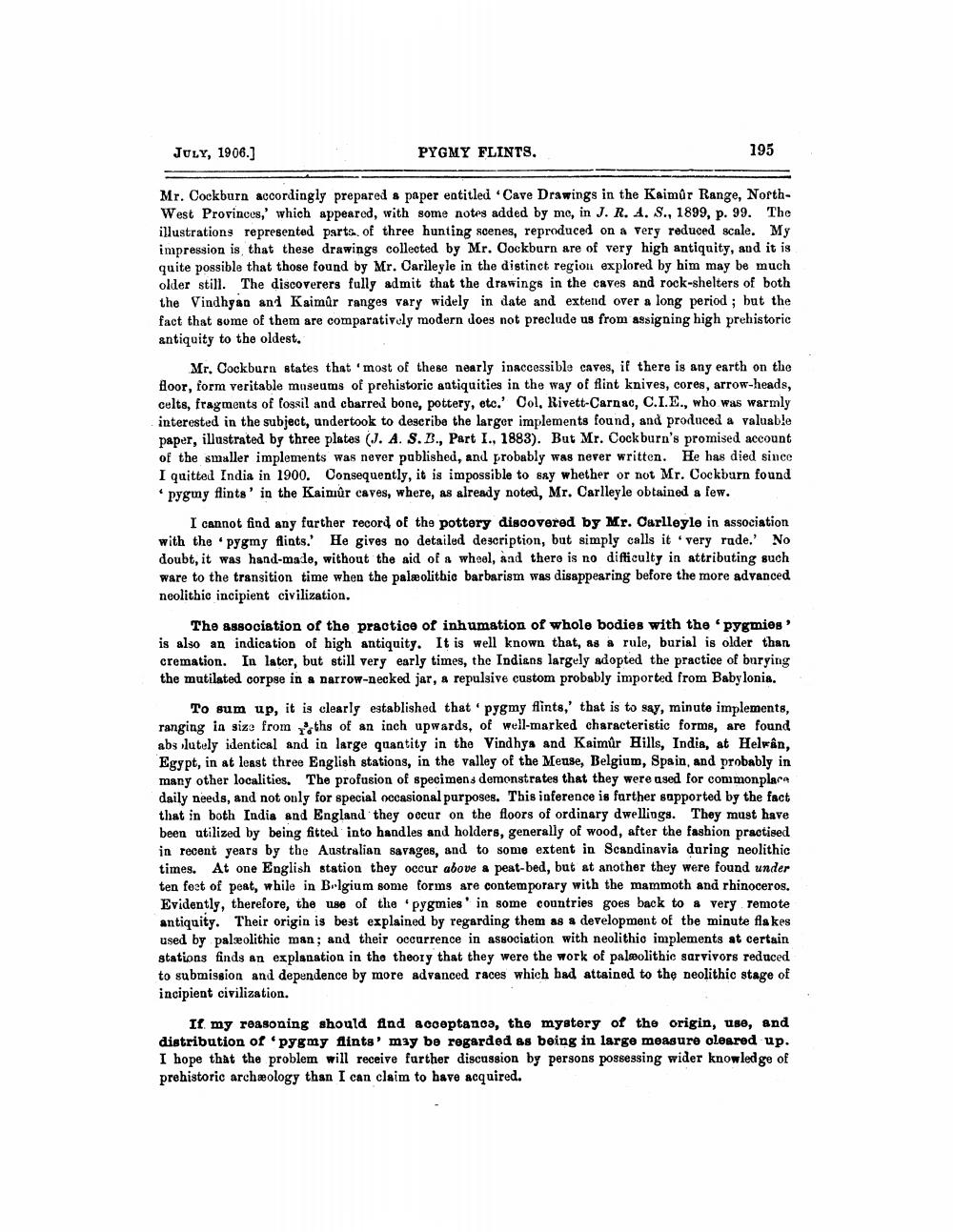________________
JULY, 1906.]
PYGMY FLINTS.
195
Mr. Cockburn accordingly prepared a paper entitled 'Cave Drawings in the Kaimur Range, NorthWest Provinces, which appeared, with some notes added by me, in J. R. A. S., 1899, p. 99. The illustrations represented parts of three hunting scenes, reproduced on a very reduced scale. My impression is that these drawings collected by Mr. Cockburn are of very high antiquity, and it is quite possible that those found by Mr. Carileyle in the distinct region explored by him may be much older still. The discoverers fully admit that the drawings in the caves and rock-shelters of both the Vindhyan and Kaimûr ranges vary widely in date and extend over a long period; but the fact that some of them are comparatively modern does not preclude us from assigning high prehistoric antiquity to the oldest,
Mr. Cockburn states that most of these nearly inaccessible caves, if there is any earth on the floor, form veritable museums of prehistoric antiquities in the way of flint knives, cores, arrow-heads, celts, fragments of fossil and cbarred bone, pottery, etc.' Col, Rivett-Carnac, C.I.E., who was warmly interested in the subject, undertook to describe the larger implements found, and produced a valuable paper, illustrated by three plates (J. A. S. B., Part I., 1883). But Mr. Cockburn's promised account of the smaller implements was never published, and probably was never written. He has died since I quitted India in 1900. Consequently, it is impossible to say whether or not Mr. Cockburn found pygmy flints' in the Kainûr caves, where, as already noted, Mr. Carlleyle obtained a few.
I cannot find any further record of the pottery discovered by Mr. Carlleyle in association with the pygmy Aints. He gives no detailed description, but simply calls it very rade. No doubt, it was hand-made, without the aid of & wheel, and there is no difficulty in attributing such ware to the transition time when the palæolithic barbarism was disappearing before the more advanced neolithic incipient civilization,
The association of the practice of inhumation of whole bodies with the pygmies' is also an indication of high antiquity. It is well known that, as a rule, burial is older than cremation. In later, but still very early times, the Indians largely adopted the practice of burying the mutilated corpse in a narrow-necked jar, a repulsive custom probably imported from Babylonia.
To sum up, it is clearly established that pygmy flints,' that is to say, minute implements, ranging in size from 'oths of an inch upwards, of well-marked characteristic forms, are found absolutely identical and in large quantity in the Vindhya and Kaimûr Hills, India, at Helvan, Egypt, in at least three English stations, in the valley of the Meuse, Belgium, Spain, and probably in many other localities. The profusion of specimens demonstrates that they were used for commonplare daily needs, and not only for special occasional purposes. This inference is further supported by the fact that in both India and England they occur on the floors of ordinary dwellings. They must have been utilized by being fitted into handles and holders, generally of wood, after the fashion practised in recent years by the Australian savages, and to some extent in Scandinavia during neolithic times. At one English station they occur above a peat-bed, but at another they were found under ten fost of peat, while in Belgium some forms are contemporary with the mammoth and rhinoceros. Evidently, therefore, the use of the pygmies' in some countries goes back to a very remote antiquity. Their origin is best explained by regarding them as a development of the minute flakes used by paläolithic man; and their occurrence in association with neolithio implements at certain stations finds an explanation in the theory that they were the work of palmolithic sarvivors reduced to submission and dependence by more advanced races which had attained to the neolithic stage of incipient civilization.
It my reasoning should find acceptanca, the mystery of the origin, use, and distribution of pygmy flints' may be regarded as being in large measure oleared up. I hope that the problem will receive further discussion by persons possessing wider knowledge of prehistoric archæology than I can claim to have acquired.




